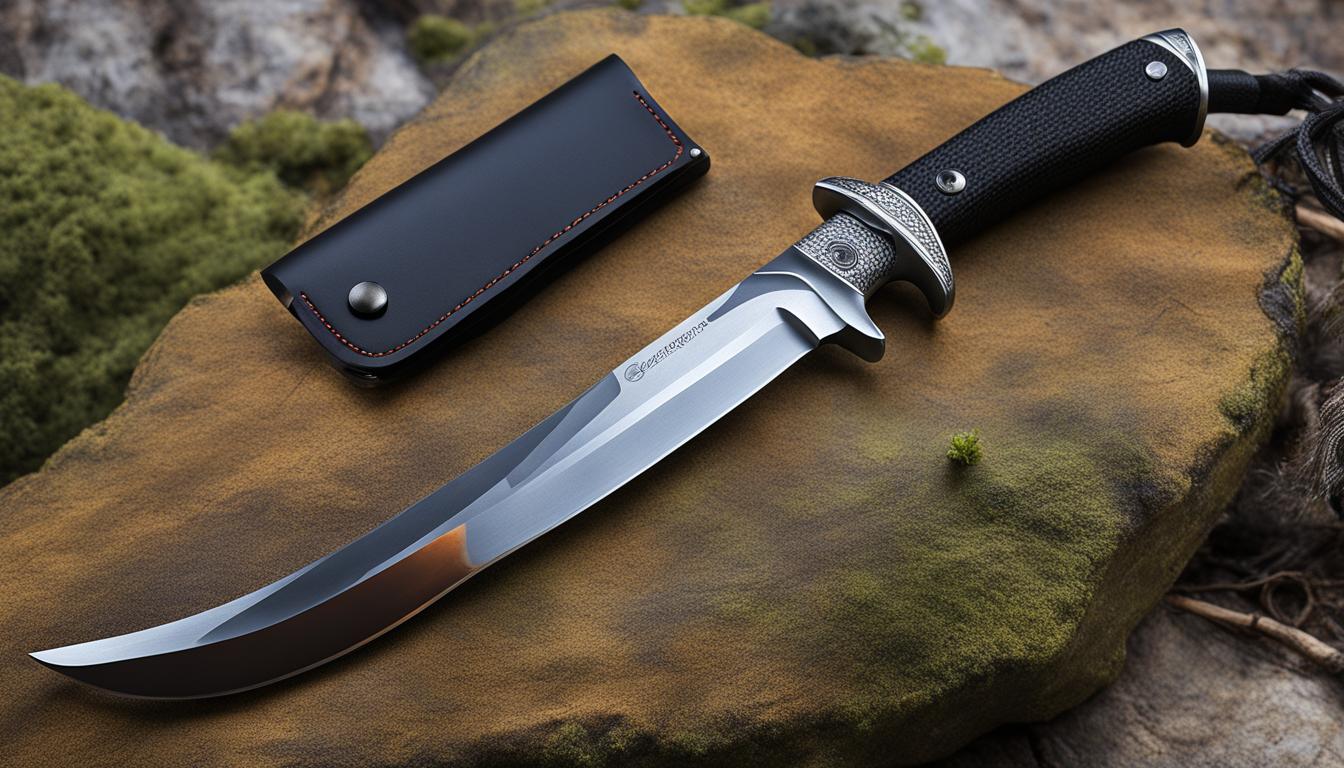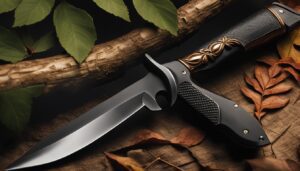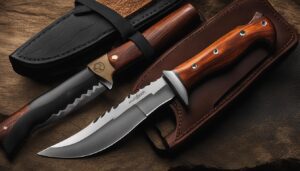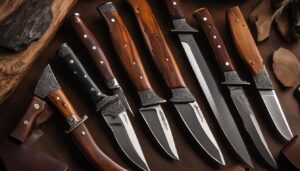Hunting knives are essential outdoor equipment that offer usability, adaptability, and dependability. Whether you are an experienced hunter or a novice exploring the great outdoors, having a high-quality hunting knife is necessary for a variety of tasks like skinning, cutting, and even self-defense. In order to choose the right hunting knife, you need to consider factors such as the shape and type of blade, the type of steel used, the knife’s handle, the tang, and the sheath. By evaluating these criteria, you can ensure that you have a durable and reliable tool for your expeditions.
Key Takeaways:
- A large hunting knife is an essential tool for outdoor adventures.
- Consider factors such as blade shape, type of steel, handle, tang, and sheath when choosing a hunting knife.
- Different types of hunting knives are suited for specific tasks.
- Choose a hunting knife that meets your specific needs and tasks.
- Durability and quality are crucial when selecting a hunting knife.
Criteria for Choosing the Right Hunting Knife
When selecting a hunting knife, several criteria should be taken into consideration to ensure you choose the right one for your needs. Let’s explore the key factors that will guide your decision-making process.
Blade Shape
The shape of the blade determines the knife’s functionality and performance in different tasks. A drop point blade provides strength and versatility, making it suitable for a variety of tasks such as skinning and general cutting. On the other hand, a clip point blade offers a sharper tip, making it ideal for precision tasks like piercing and detail work.
Type of Steel
The type of steel used for the blade affects its strength, durability, and ability to maintain an edge. Stainless steel blades are known for their corrosion resistance, making them suitable for outdoor use in wet conditions. Carbon steel blades, on the other hand, are preferred for their superior edge retention and ease of sharpening.
Knife Handle
The handle of a hunting knife should provide a secure and comfortable grip, especially during rigorous outdoor activities. Common handle materials include wood, rubber, plastic, and composites. Wood handles offer a classic and natural appeal, while rubber and plastic handles provide excellent grip even in wet conditions. Composites offer a balance of durability and comfort.
Tang and Sheath
The tang refers to the portion of the blade that extends into the handle. A full tang knife, where the blade extends through the entire handle, offers maximum strength and durability, making it suitable for heavy-duty tasks. Additionally, ensure that the sheath is sturdy and reliable for safe storage and transportation of the knife.
| Criteria | Options |
|---|---|
| Blade Shape | Drop point, clip point |
| Type of Steel | Stainless steel, carbon steel |
| Knife Handle | Wood, rubber, plastic, composites |
| Tang | Full tang |
| Sheath | Sturdy and reliable |
By considering these criteria, you can make an informed decision and choose a hunting knife that meets your specific needs, ensuring a reliable and durable tool for your outdoor adventures.
“The tang of a hunting knife plays a crucial role in its strength and durability, so it’s important to choose a knife with a full tang. Additionally, the blade shape and type of steel should be selected based on the specific tasks you will be performing, while the handle material should provide a comfortable and secure grip. Lastly, don’t forget to invest in a sturdy sheath for safe storage and transportation of your hunting knife.”
Bushcraft Knives vs. Traditional Hunting Knives: Which Is Right for You?
When it comes to outdoor activities, having the right knife is essential. But with so many options available, how do you decide between a bushcraft knife and a traditional hunting knife? Let’s take a closer look at the characteristics and uses of each to help you make an informed decision.
Bushcraft Knives
Bushcraft knives are designed to handle a variety of tasks in the wilderness. They are versatile tools that can be used for starting fires, building shelters, carving wood, and even preparing food. These knives often have a slightly longer blade, allowing for more precise cutting and carving. The shape of the blade is usually straight or slightly curved, making it easier to control. Bushcraft knives are built to be durable and reliable, capable of withstanding harsh conditions and demanding outdoor activities.
Traditional Hunting Knives
On the other hand, traditional hunting knives are specifically designed for hunting and processing game. They excel at tasks such as skinning, gutting, and butchering animals. Hunting knives often have a sharper, curved blade to facilitate precise cuts. The overall size and shape of the knife will depend on the specific task at hand, with some knives specializing in skinning while others are more versatile for various hunting tasks.
When choosing between a bushcraft knife and a traditional hunting knife, consider the nature of your outdoor activities. If you plan on engaging in a range of tasks beyond hunting, such as bushcraft and survival skills, a bushcraft knife may be the better choice. However, if your primary focus is hunting and processing game, a traditional hunting knife will serve you well. Ultimately, the decision comes down to your specific needs and the tasks you intend to perform during your outdoor adventures.
| Criteria | Bushcraft Knife | Traditional Hunting Knife |
|---|---|---|
| Primary Use | Versatile outdoor tasks | Hunting and game processing |
| Blade Shape | Straight or slightly curved | Sharp and curved |
| Size | Slightly longer blade | Varies based on task |
| Grip | Ergonomic for various tasks | Comfortable for hunting |
| Materials | Durable and reliable | Focused on hunting needs |
Both bushcraft knives and traditional hunting knives have their own advantages and are well-suited for specific purposes. Consider the tasks you will be performing, the durability of the knife, and the ergonomic grip that feels comfortable in your hand. By carefully evaluating these factors, you can choose the knife that will best serve you during your outdoor adventures.
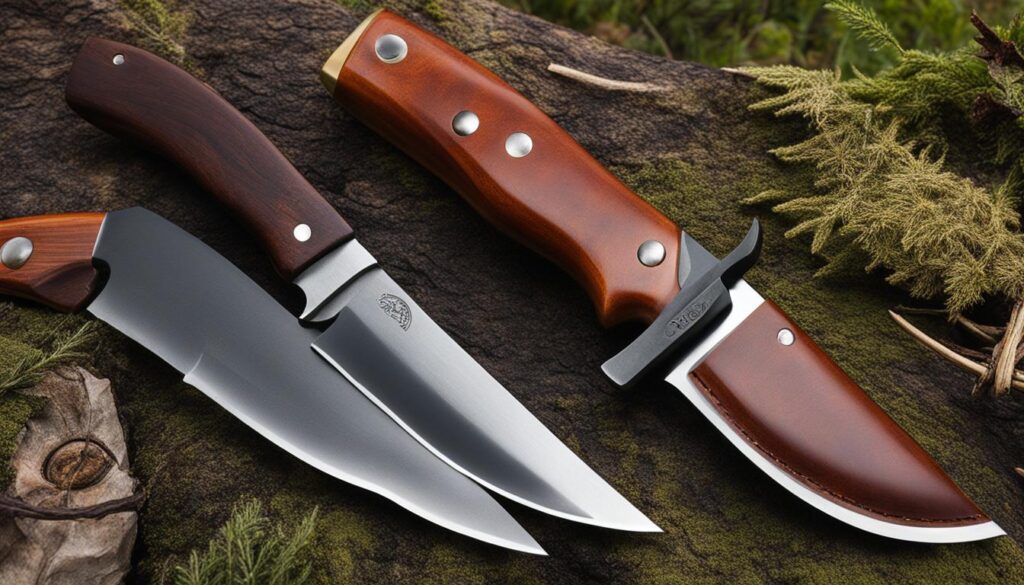
Types of Hunting Knives and Their Uses
When it comes to hunting knives, there are various types available, each suited for specific tasks. Understanding the different types of hunting knives and their uses can help you make an informed decision on which one is right for your outdoor adventures. Let’s explore some of the most common types:
Bowie Knife
The Bowie knife is a versatile option with a long, wide blade. It is well-known for its ability to perform a range of tasks, making it a popular choice among hunters. With its size and shape, the Bowie knife can be used for skinning, butchering, and even chopping wood.
Skinner
The skinner, as the name suggests, is specifically designed for skinning animals. It features a small, sharp blade with a curved edge, allowing for precise and controlled movement. If you frequently engage in activities that require skinning, a skinner knife is an essential tool to have in your arsenal.
Bushcraft Knife
The bushcraft knife is a multi-purpose hunting knife that is slightly longer than other types. It is designed to handle larger game and perform various tasks, making it ideal for outdoor enthusiasts who engage in different activities. Whether you need to build a shelter, start a fire, or carve wood, a bushcraft knife is a versatile option.
Gut Hook Knife
The gut hook knife is specialized for gutting animals. It features a curved blade with a small, sharp hook at the tip. The hook is used to open the animal’s abdomen without puncturing the internal organs, allowing for efficient gutting. If you frequently hunt and prepare your own game, a gut hook knife can be a valuable tool.
Larger Knives
In addition to the specific types mentioned above, there are larger hunting knives that serve unique purposes. The drop point knife and the spear point knife, for example, are larger knives used for piercing an animal’s heart or making clean cuts. These knives are often favored by hunters who require a more robust tool for their expeditions.
Understanding the different types of hunting knives and their uses can help you choose the right tool for your specific needs. Whether you opt for a versatile Bowie knife, a specialized skinner, or a multi-purpose bushcraft knife, selecting the right hunting knife is crucial for a successful and enjoyable outdoor adventure.
Choosing the Right Hunting Knife for Your Needs
When it comes to selecting the right hunting knife, it’s essential to consider the specific tasks you’ll be performing. Whether you’re skinning game or butchering meat, different types of hunting knives are designed to excel at specific tasks. By understanding the various types of hunting knives and their uses, you can make an informed decision that meets your needs.
For skinning tasks, a dedicated skinning knife is the ideal choice. With a curved blade, these knives allow for controlled movement, making it easier to remove the hide from the animal. On the other hand, if you’ll be butchering game, a Bowie knife with its long, wide blade is recommended. This type of knife is versatile and can be used for a variety of cutting and chopping tasks.
It’s worth noting that having multiple hunting knives for different tasks can be advantageous. This allows you to have the right tool for each specific job, ensuring precision and efficiency. When purchasing a hunting knife, consider the handle materials as well. The handle should provide a secure grip, especially in wet or cold conditions. Look for materials like rubber or composites that offer both durability and comfort.
| Type of Hunting Knife | Recommended Use |
|---|---|
| Skinner | Skinning animals with controlled movement |
| Bowie Knife | Butchering tasks and versatile cutting |
| Bushcraft | Multi-purpose knife for larger game |
| Gut Hook | Gutting animals with a curved blade and sharp point |
| Drop Point | Piercing an animal’s heart or making clean cuts |
It’s important to choose a hunting knife that suits your specific needs and preferences. BigCat Knife offers a range of handmade hunting knives with different handle materials, ensuring you can find the perfect knife for your outdoor adventures. By selecting the right type of hunting knife and handle material, you can have confidence that your knife will meet the demands of your tasks and provide you with a reliable tool for years to come.
Conclusion
When it comes to outdoor adventures, choosing the right hunting knife is essential. By carefully considering the criteria such as blade shape, type of steel, handle materials, tang, and sheath, you can make an informed decision. Durability and quality should be your top priorities when selecting a hunting knife that will withstand the demands of your tasks.
Whether you’re looking for a large hunting knife, a specialized skinner, or a versatile bushcraft knife, it’s important to choose one that aligns with the specific tasks you’ll be performing. Remember, each knife has its own unique advantages and uses, so take the time to evaluate your needs before making a purchase.
With the right hunting knife in hand, you can enhance your outdoor adventures and have a reliable tool for a variety of tasks. So, take your time, consider the criteria, and choose a hunting knife that will stand up to the challenges you’ll face in the great outdoors.
FAQ
What factors should I consider when choosing a hunting knife?
When choosing a hunting knife, it is important to consider factors such as the shape and type of blade, the type of steel used, the knife’s handle, the tang, and the sheath.
What is the difference between bushcraft knives and traditional hunting knives?
Bushcraft knives are designed for various outdoor tasks like starting a fire and carving wood, while traditional hunting knives are specialized for skinning, gutting, and butchering animals.
What are the different types of hunting knives available?
There are various types of hunting knives available, including the Bowie knife, skinner, bushcraft knife, gut hook knife, and larger knives like the drop point and spear point.
How do I choose the right hunting knife for my needs?
To choose the right hunting knife, consider the tasks you will be performing. If you will be doing a lot of skinning, a skinning knife is suitable. It is also beneficial to have multiple hunting knives for different tasks.
Where can I purchase a hunting knife with different handle materials?
BigCat Knife offers a variety of handmade hunting knives with different handle materials to choose from.
Why is choosing the right hunting knife important?
Choosing the right hunting knife is crucial for a successful outdoor adventure. By considering criteria such as blade shape, type of steel, handle materials, tang, and sheath, you can select a hunting knife that meets your specific needs.
